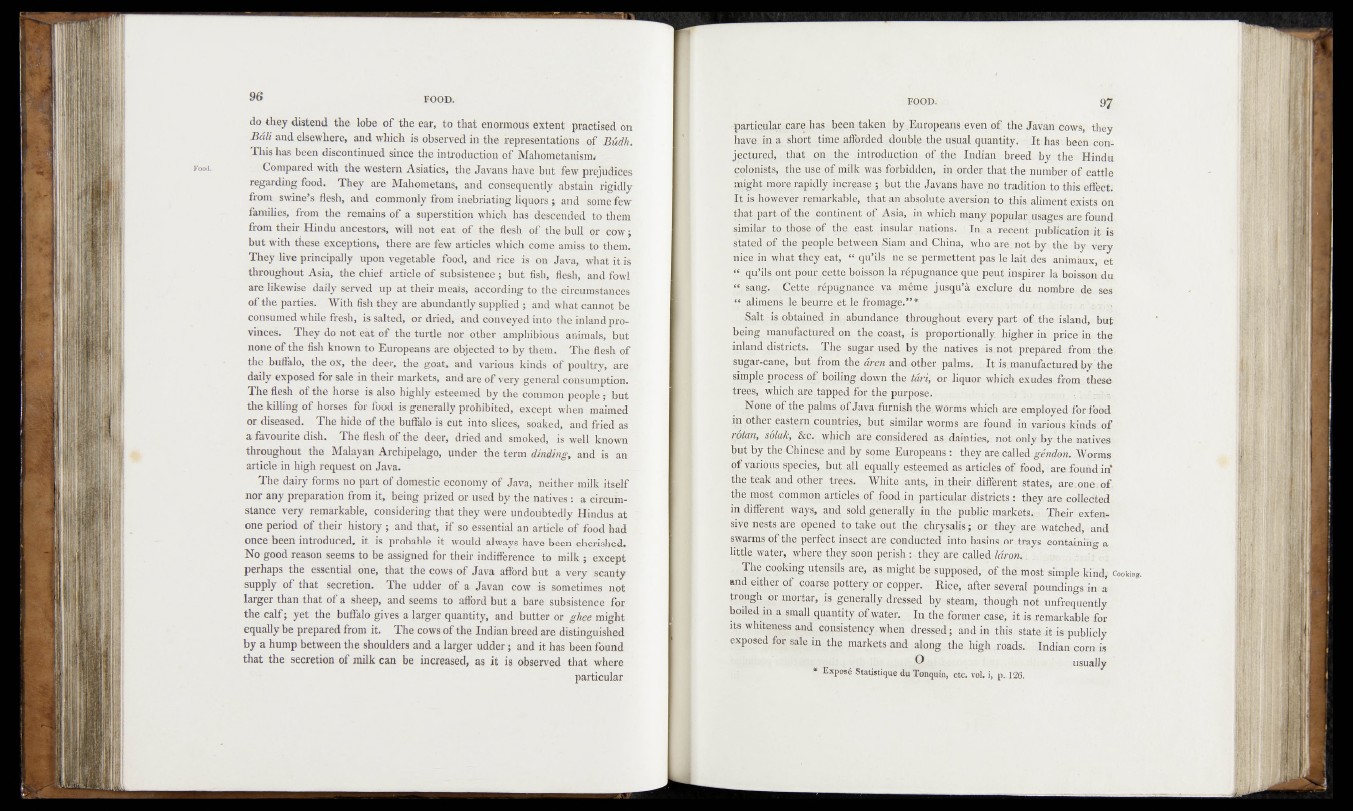
do they distend the lobe of the ear, to that enormous extent practised on
S M and elsewhere, and which is observed in the representations of BMh.
This has been discontinued since the introduction of Mahometanism*
Compared with the western Asiatics, the Javans have hut few prejudices
regarding food. They axe Mahometans, and consequently abstain rigidly
from swine’s flesh, and commonly from inebriating Kquors; and some few
families, from the remains of a superstition which has-descended to-them
from their Hindu ancestors, will not e a t,o f,th e flesh of the bull or cow;
hut with these exceptions, therfe are few articles which come amiss to %h'em.
They live principally upon vegetable food, and rice is on Java, what it.is
throughout Asia, the chief article df Subsistence; but fish, flesh, and fowl"
are likewise daily served up at their meats, according to th© circumstances
of the parties. With fish they are abundantly supplied ; and what cannot be
consumed while fresh, is salted, or dried;-and conveyed into the inland provinces*
They do no t eat of the turtle nor other amphibious animals, but
none of the fish known to Europeans are objected to by them. The flesh df
|h e buffalo, the ox, the deer, the ^oat, and various kinds of poultry* are
daily exposed for sale in their markets, and are of very general consumption.
The flesh of the horse is also highly esteemed by the common people f but
the killing of horses for food is generally prohibited, except when maimed
or diseased. The hide of the buffalo is cut into slices, soaked, and fried as
a favourite dish. The flesh of the deer, dried and smoked, is well known
throughout the Malayan Archipelago, under the term dmding, and is an
article in high request on Java.
The dairy forms' no part of domestic economy-of-Java, neitber-milk-itself
nor any preparation from it, being prized or used by the natives: a eircuhi-
slance very remarkable, considering that they were undoubtedly Hindus, at
one period of their history; and that, if so essential an article of food had
once been introduced, it is probable it would always have been cherished.
No good reason seems to be assigned for their indifference to milk ; except
perhaps the essential one, that the cows of Java afford hut a very scanty
supply of that secretion. The udder of a Javan cow is. sometimes not
larger than that o f a sheep, and seems to afford but a bare subsistence for
the calf; yet the buffalo gives a larger quantity, and butter or gh$e might
equally be prepared from it. The cows of the Indian breed are distinguished
by a hump between the shoulders and a larger udder; and it has been found
that the secretion of milk can be increased* as it is observed that where
particular
-partieular!tcar^fbasy;b e e ^ a k e n îjby{EuropeansLev,en .of, the Javan.cows, they
h^veni^m sho^.time^affor.d^d-rdoub^ejthe usuaLquantjty. Tt-has - heeil conjectured.
pfihat p n a'thÿ tjnt^j3(^ti^tio,ri.. .of jthe, IndianirbréedVbyn'itJiè' - Hindu
qpMmsfs^^tbe us^f^milk wasi£orbidden.win,..or,der. thatthemiimW n f cattle
iujg^tTmo.i;e) f^nidly^increaseA.: .butathe-Javans.havp^inn .tradition-to ‘this effect:
’ M is howeye^j^markable, that jap^h^nteJ.laYersionJto.ritbiSialiment exists on
^P.QAtiaeuf popular^usages-are found
sj^i^rUjto^thqse;'©f( th^easf .insujaE^patio.ns.- In? aspect-ipublicatioruit-is
sta te d ^ ^hgj,g^pphjbe(tween.^ianr and^C^ina^, liW^;-arolinpt ;byi the by-very
i-mfls Æe^^nermcttént- pas .le imfeJ&i animaux,- et
h qu’ilk ont, Douacett&.bqisson..la repugnance qjiq’&i^ripspiçerja boisson, du
■ BlS sanm^J^ffite- répugnance.;ya„même, jusqu’à qxcjure,-du. nombre de ses
“ ■ m^nsdleAenrre atje frqmage,” * -,
, taj.ne^d pn^abundance ‘ throughq4nti.iev:ery part, o%.th'eyisland, huf
i ï ^ E ^ b ja-Bufafitok^pn ^ f p ^jfep^g-'prOpocfeionally' hig h e n price in the
ÎSteii ;®uS^r . used by the nativeg.sisjnpt! prepared; rfrom, the
jj^en pnd <$ther paljms.-djlt is.manufactured'by the
the tari, or liquor-whicb^exudesc-from i these
trgp^j purpose.; I
f i P t h e - worms, which are employed for:fotrd
în worms jàr.e,ibund,jin^yaxious .kinds of
ag; dainties,- ndfeôJtjlyi-by thé-jnatives
h u ^ ^ d h p ^ h in ^ g and by soçqe-Europeans : th.ey;are called g&ndon: Worms
esteemed*- as.articlès ofi fl)od,i are.fbuhd in
' , janfà,. in.theirj different;'Statfes;n areionerof.
particular ^districts; they, are^collected
in different, wg^, andj gold generally ip, the public- roarkets^.I^heir extern
Si ^ - a f st?Æe ,°PePed to tak e ;oufc Jhe^chrysalis ;rjpp;they-iare .watched, and
swarms o£J^Mrfectdnsect. are conducted' into basins or strays containing a
wafer, where they^sopnperish : - they .are c$\}$&-laron{{ |
TherP°Swg r a?, might be « supposed, ofthmmosjt simple kind? Cookiag.
an4 f R?^9^;9E(Ç°PPer. Rice,c after; sèveraF poundingsin - a
trough ( pr morfar, js generflll^dpessed, by steam, dhough no.ti unfrequently
boded..ip ,^ m ^ \ .quantity of,water. „ In.thq,fprmer>case; itds Remarkable for
its whiteness anfl^consistency.when dresged,; and-.in. this, state',it.-isjpublicly
exposed for sale in the markets .and along,, the high .roads.. Indian; corn is
O , usually
* Exposé Statistique du Tonquin, etc. vol* 126.